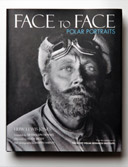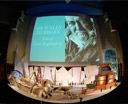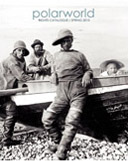 Our ProductsOur Resources |
This website requires the free Flash plugin to be installed.
Polarworld - discover more polar booksThe Arctic Book Review A Kayak Full of Ghosts: Eskimo Folk Tales A Kayak Full of Ghosts: Eskimo Folk Tales Retold by Lawrence Millman Reviewed by Russell A. Potter Lawrence Millman's gift for storytelling is well-known to most readers of Arctic lore; the best of his books, such as Last Places: A Journey in the North, and Lost in the Arctic, are classics of the genre. Millman's gift, and a rare one it is, is to be able to combine his own pithy observations with the gab and blather of the quite distinctive people he meets, a gift apparent in his very first book, Our Like Will Not Be There Again: Notes From the West of Ireland. In that book, he introduced us not to the fanciful, peat-smoke suffused "West" of song and story, but to a series of indelible and singular characters, among them a peripatetic poet who simply declared, "After me, it'll be dead. Poetry, I mean." Not surprisingly, it was this gift for picking up the precise tenor of encountered voices – as well as a penchant for bursting the bubble of popular conceptions of people and places – which first turned Millman's interests in a northerly direction. As the preface to this book describes it, Millman was hospitalized for hypothermia after taking an unexpected dip below the ice off the coast of Greenland. Confined to a tiny hospital which was also served as a drying-out tank, he turned his ear to a man who was there for the latter purpose, and acquired from him the first of the more than a hundred tales which make A Kayak Full of Ghosts the most memorable – and entertaining – collection of Eskimo folk tales ever compiled. A word should perhaps be said here about the term "Eskimo" – which has been strongly rejected by the Inuit of the Canadian Arctic – but which, given the wide geographical range of Millman's sources, seems appropriate for this collection. In Greenland, source for many if not most of these stories, "Eskimo" is not considered offensive, and the term has the advantage of including the full range of modern indigenous peoples from Alaska to Greenland. And, should any whose notions of the North were formed by the depictions of Eskimos in popular culture happen upon this book, they would likely receive such a shock that their stereotypes would never recover. For this book is not for the faint of heart, nor for those who keep their anthropological lenses in one suitcase and their sense of humor in another. With tales such as "The Spirit of the Shit-Pile," "Ussarqak, who Ate Too Many Heads," and "The Penis of the Lake," Millman brings his readers into the surrealistic world of monstrous, detachable, animate body parts which circles the Arctic as certainly as the aurora. Some years ago, when I first encountered the writings of Alootook Ipellie, I took him for a sort of Arctic version of William S. Burroughs, and supposed that his wild tales of Nazi seals, women giving birth to geese, and a slightly psycho God named Satanassee (Satan), were but the singular products of a fevered mind. Which they were, but any one of them has its corollaries in these tales, which document as no "serious" anthropological collection has the collective fever, and wry humor, of the entire Eskimo tradition. Of course not all of these tales are as outrageous and strange as those I have so far mentioned. The stories are grouped under several heads, among them "Origins and Ancestors," "Children," and "Death and Old Age." Many of them are more playful than frightening: there's Tugtutsiak, who, unable to find a wife, marries a rock and lives happily ever after; a fly whose life is spared by a kind child, only to be crushed a moment later on a man's nose; and then there are the "Northern Lights Children," hungry waifs who remind a hunter of the need to share his catch. Shamans, ghosts, and spirits abound, and all of them are hungry, proud, and unpredictable. The only stories not much represented here are precisely the kind that most interest anthropologists, which is to say, stories that can be properly thought of as mythological. Over the years, a concerted effort to boil down the tangled lines of Eskimo traditions into some single cosmology has occupied generations of anthropologists. Distortions have arisen, precisely because of characters such as Nerrivik (more widely known as Sedna), who is at once a foolish and disobedient daughter killed by her parents and a powerful spirit responsible for the survival or death of whole communities. Myth or story? has been the question, and it's been the wrong one for a tradition in which nearly everything is both. Millman wisely intermingles all kinds in his selection, and even those in the "Origins and Ancestors" section are often quite simple and light-hearted. A Kayak Full of Ghosts has been unavailable for too long, and the appearance of this new edition from Interlink Books is an occasion for celebration; with any luck, it will rescue this rich tradition from the hands of anthropologists for years to come. |
|
||
follow us  | join us | join us  | home | contact | home | contact
|
||||
|
© Copyright Polarworld Ltd
SiteWizard.co.uk Web Site Design Company |
||||


